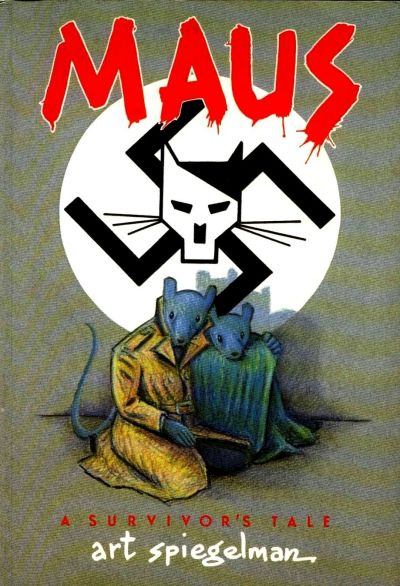 Maus: A Survivor's Tale
Maus: A Survivor's Taleby Art Spiegelman
reviewed by Teagan O'Hara
The intriguing graphic novel Maus by Art Spiegelman depicts one Jewish man and his family’s struggle to survive through war-torn Poland during World War II. “Artie,” the author, tells Vladek’s (his father) story with symbolic illustrations that portray the innocent Jews as mice, the truculent Nazis as cats, and the Polish as pigs.
With this multi-genre story, Spiegelman manages to make learning about the horrors of Jewish discrimination, the Holocaust, and the aftermath of the destruction of World War II even more interesting. The graphic novel includes both rough sketches of past events told by Vladek and Vladek’s current reactions to his retelling of the traumatizing memories. The toll the experience took on Vladek is evident throughout the book, as he frequently denies to go into detail on certain topics and reveals that he burned Artie’s dead mother’s journals that contained valuable accounts of her experiences.
Maus itself begins with one of Artie Spiegelman’s childhood memories. “If you lock [your friends] together in a room with no food for a week,” says Vladek Spiegelman, “Then you could see what it is, friends!” (Spiegelman 6). In the novel’s present day, Artie visits his father in New York to ask him about his experiences in the war. He records Vladek’s story on his tape recorder. The novel goes back and forth between the present and past with Artie’s own commentary on what Vladek says. Vladek speaks about his textile business, his marriage to Artie’s mother, his time in German ghettos, Auschwitz, and how he escaped.
When the first strips of Maus were first published in 1980, they received many positive comments and feedback from the public. However, some claimed that the representation of different races as different animals was inaccurate. Although the illustrations of the Jews as mice and the Germans as cats could be seen as one predatory species hunting another, there are many inconsistencies. Other than their tails and heads, the characters are really just human beings. Anja is afraid of mice (she is a mouse herself), characters have pets, and the “cats” use hunting dogs. Also, the depiction of the Polish as pigs could be potentially racist since Jews are known not to associate with pigs. Readers might also encounter some confusion in the second half of the book through Artie’s “identity crisis.” Instead of drawing himself and the people around him as certain animals that identify their race like he usually would, he crudely draws people with animal masks tied onto their faces.
Overall, this book is very fascinating to read. The artwork makes it easier for readers to understand what is going on. It provides a good visual aid to help with comprehension of the characters’ situations.
No comments:
Post a Comment